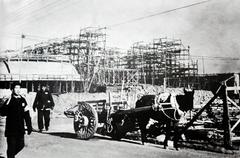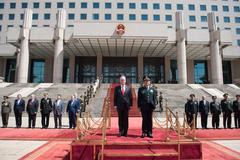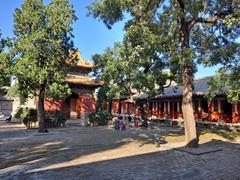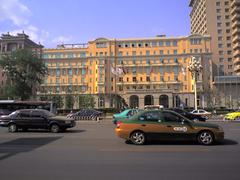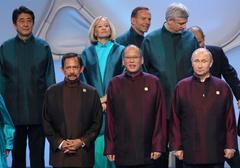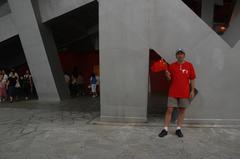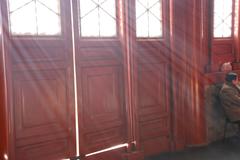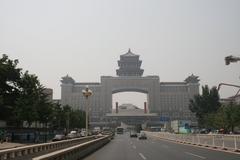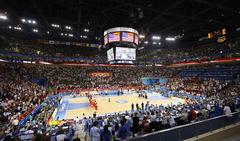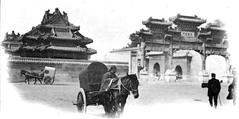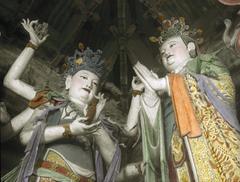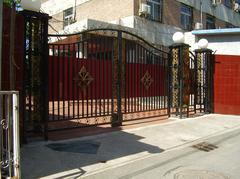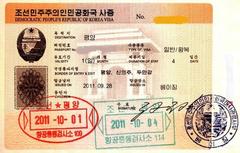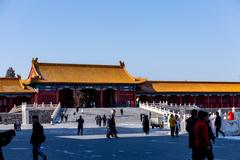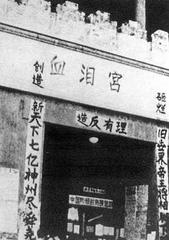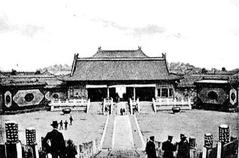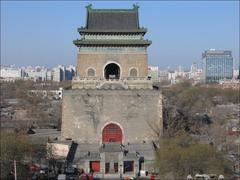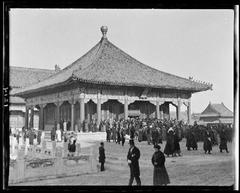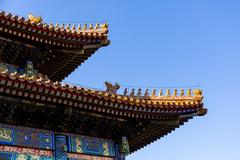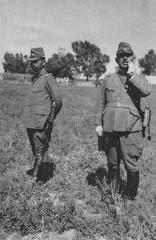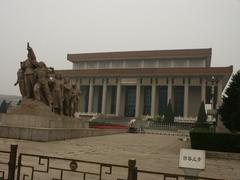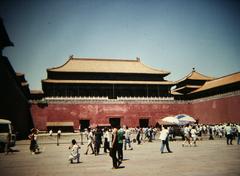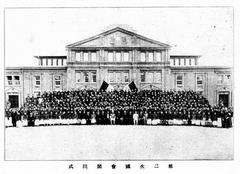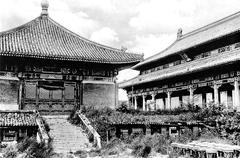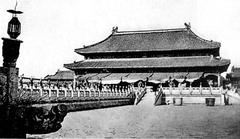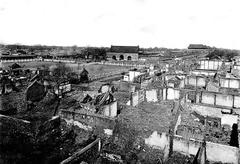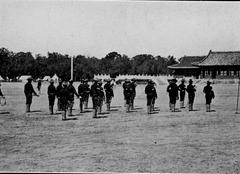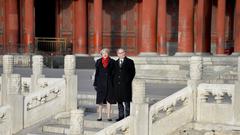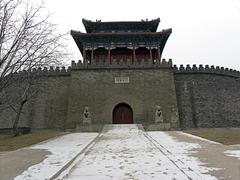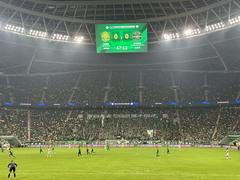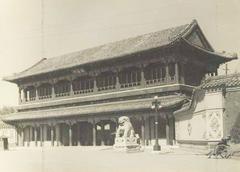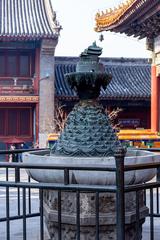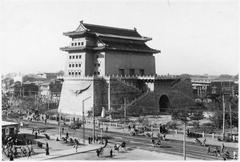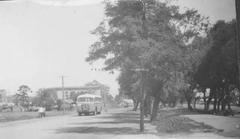
Anli Road Beijing: Visiting Hours, Tickets, Historical Sites & Travel Guide
Date: 04/07/2025
Introduction
Anli Road (安立路), located in Beijing’s Chaoyang District, stands as a symbol of the city’s rapid modernization and urban transformation. Once on the city’s rural periphery, Anli Road today links world-renowned Olympic landmarks with a vibrant mix of residential, commercial, and recreational spaces. Its strategic location near the Olympic Green and role in Beijing’s development since the 2008 Summer Olympics highlight its importance as a gateway to both local life and international venues. This guide offers a detailed overview of Anli Road’s historical evolution, key attractions, transport options, and visitor tips to help you experience the best of this dynamic urban corridor.
For more information, see Wikipedia: Chaoyang, Beijing, China Discovery’s Beijing Guide, and the Beijing Government’s Chaoyang Greenway page.
Table of Contents
- Historical Background
- Urban Development & Olympic Legacy
- Key Attractions and Sites
- Visitor Information (Hours, Tickets, Accessibility)
- Transportation Guide
- Local Life, Dining, and Shopping
- Sustainable Urban Renewal
- FAQs
- Summary of Key Transformations
- References
Historical Background
Anli Road’s story is rooted in Beijing’s northern expansion. Historically, this area was agricultural land on the city’s outskirts, playing a buffer role between urban Beijing and its rural surroundings (Wikipedia: Chaoyang, Beijing). The name “Anli” is relatively modern, emerging as the area developed in the late 20th and early 21st centuries in response to Beijing’s economic and population growth.
Urban Development & Olympic Legacy
Modern Planning and Growth
From the 1990s onward, Anli Road became a focal point for new residential, commercial, and recreational projects. Its transformation accelerated as Beijing prepared for the 2008 Summer Olympics, culminating in the creation of the Olympic Green—home to the National Stadium (Bird’s Nest), National Aquatics Center (Water Cube), and Olympic Forest Park (The Daily CPEC: Chaoyang District).
Olympic Impact
The Olympics brought extensive infrastructure upgrades: road expansions, landscaping, public amenities, and the introduction of subway Line 8 and Anli Lu station. The area’s urban fabric now intertwines modern housing, international schools, shopping malls, and green spaces, reflecting Beijing’s global outlook and commitment to sustainability (Wikipedia: Anli Lu station).
Key Attractions and Sites
Olympic Green
- Beijing National Stadium (Bird’s Nest): Iconic Olympic venue, open daily 9:00 AM–6:00 PM, tickets ~50 RMB. Wheelchair accessible (China Discovery).
- National Aquatics Center (Water Cube): Famous for its bubble-like facade, open 9:00 AM–7:00 PM, tickets ~80 RMB. Features an indoor water park and event spaces.
- Olympic Forest Park: A vast urban oasis, open 6:00 AM–9:30 PM, free entry. Ideal for jogging, cycling, and relaxation.
Cultural and Leisure Sites
- China Science and Technology Museum: Interactive exhibits, open Tues–Sun 9:00 AM–5:00 PM, tickets ~30 RMB. Popular with families and school groups.
- National Convention Center: Major venue for business events and exhibitions.
Hotels
- Marco Polo Parkside Hotel: Five-star accommodation at 78 Anli Road, offering luxury, convenient access to Olympic venues, and a variety of dining and fitness amenities (Hotel Whisperer).
Shopping & Dining
- North Star Shopping Center: Modern mall with international and local brands, diverse dining options.
- Local Eateries: Wide range of restaurants featuring Beijing cuisine and international choices.
Green Spaces
- Anli Road Greenway: Tree-lined sidewalks and cycling lanes connect parks and promote healthy urban living.
- Nearby Parks: Beichen and Huixin Parks offer playgrounds and quiet retreats.
Visitor Information
Visiting Hours
- Anli Road: Public street, open 24/7.
- Olympic Green: 6:00 AM–10:00 PM.
- Attractions: Vary by site; Bird’s Nest and Water Cube generally 9:00 AM–6:00/7:00 PM.
Tickets
- Anli Road & Greenway: Free.
- Bird’s Nest: ~50 RMB.
- Water Cube: ~80 RMB.
- Olympic Forest Park: Free.
Accessibility
- Wide, smooth pavements and accessible subway stations with elevators.
- Major attractions equipped for wheelchair users.
Travel Tips
- Spring and autumn are the best seasons for comfortable exploration.
- Use the Anli Lu subway station (Line 15) or Olympic Green station (Line 8) for easy access.
- Consider guided tours, especially for the Olympic venues.
- Carry a translation app as English signage is limited outside main attractions.
Transportation Guide
Subway
- Line 8: Directly serves Olympic Green and southern Anli Road.
- Line 15: Connects to Anli Lu Station, with transfers to the airport and other districts (China Discovery).
- Hours: 5:00–23:00, fares from 3 RMB.
Bus
- Routes 81, 82, 419, 538, 607, and others serve Anli Road and Olympic venues.
- Fares: 1–2 RMB by card or exact cash.
- Operating hours: 5:30–23:00 (China Travel).
Taxi & Ride-Hailing
- Base fare ~13 RMB for first 3 km; DiDi app available in English.
- Have your destination in Chinese.
Bicycle Sharing & Walking
- Mobike, Ofo, and other platforms; ideal for short distances and greenway access.
- Wide, safe sidewalks and bike lanes.
Accessibility
- Elevators and ramps in subway stations and major venues.
- Many buses and all Olympic venues designed for barrier-free access.
Key Transport Connections
- Beijing Capital International Airport: Via Line 15/subway or taxi (30–40 minutes).
- Beijing Railway Stations: Easily accessible via subway transfers (Hey Roseanne).
Local Life, Dining, and Shopping
Anli Road’s surroundings offer a cosmopolitan lifestyle. Residential complexes, international schools, and professional offices (including Anli Partners Law Firm) contribute to a lively, diverse community. The area’s cafés, restaurants, and shopping centers provide comfort and convenience for both tourists and locals.
Sustainable Urban Renewal
Recent years have seen Anli Road at the forefront of Beijing’s sustainability efforts. The integration of ecological parks, energy-efficient infrastructure, and green transport options aligns with citywide policies for a healthier urban environment (CGTN).
FAQs
Q: Is Anli Road considered a historical site?
A: It does not feature ancient relics but is significant as a showcase of Beijing’s modern urban and Olympic legacy.
Q: Are there entrance fees?
A: Anli Road and most green spaces are free; tickets are required for venues like the Bird’s Nest and Water Cube.
Q: How is accessibility for disabled visitors?
A: Major attractions and subway stations are wheelchair-accessible.
Q: What’s the best way to get there?
A: Subway Line 8 (Olympic Green) or Line 15 (Anli Lu), plus several bus routes.
Q: Are there hotels nearby?
A: Yes, including luxury options like the Marco Polo Parkside Hotel.
Summary of Key Transformations
- Pre-20th Century: Rural and agricultural outskirts.
- Late 20th Century: Urban expansion as part of Chaoyang District’s development.
- 2000s: Infrastructure and Olympic-driven upgrades.
- Post-2008: Ongoing growth as a commercial, residential, and recreational hub.
Anli Road exemplifies Beijing’s commitment to urban innovation, inclusivity, and sustainability (The Daily CPEC: Chaoyang District; Beijing Government: Chaoyang Greenway).
References and Further Reading
- Wikipedia: Chaoyang, Beijing
- The Daily CPEC: Chaoyang District
- Beijing Government: Chaoyang Greenway
- DayDayNews: Urban Development in Changping District
- Anli Partners Law Firm
- CGTN: Beijing Culture Forum
- China Discovery: What to Do in Beijing
- China Highlights: Beijing Trip Planner
- Hey Roseanne: Beijing Travel Guide
- Ruqin Travel: Beijing Public Transport Guide
- Adventures N Sunsets: Tips for Visiting Beijing
- Hotel Whisperer: Marco Polo Parkside Hotel Review

